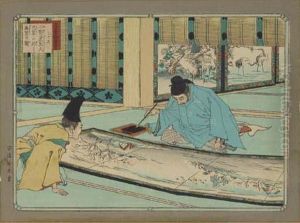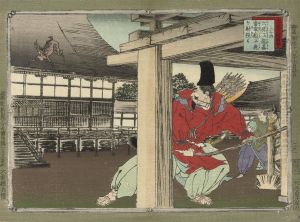Adachi Ginko Paintings
Adachi Ginko was a Japanese artist known for his work as a woodblock print designer during the late Edo and early Meiji periods. Born in 1853 in Tokyo, then known as Edo, Ginko was active during a time of great change in Japan as the country opened up to the West after more than two centuries of self-imposed isolation under the Tokugawa shogunate.
Ginko's career straddled two eras. He began his artistic training under Utagawa Yoshiiku, a student of the famous Utagawa Kuniyoshi, who was one of the last great masters of the ukiyo-e genre of woodblock prints. Ukiyo-e, which translates to 'pictures of the floating world', captured the hedonistic lifestyle of Edo's pleasure quarters, theatre, and festivals. As a student of Yoshiiku, Ginko was exposed to traditional ukiyo-e techniques and subjects, which he later adapted to his own style.
As Japan underwent rapid modernization during the Meiji Restoration which began in 1868, Ginko's work reflected the country's transformation. He produced prints that depicted current events and the Sino-Japanese War (1894-95), thus contributing to the genre of senso-e (war prints). Ginko's prints from this period often included western elements and technologies, illustrating how Japanese society was adapting to Western influence.
Throughout his career, Ginko also produced bijin-ga (pictures of beautiful women), which were a staple of ukiyo-e art. His works in this genre are noted for their delicate lines and subtle use of color. He was also known for his yakusha-e (actor prints), which depicted the popular kabuki actors of the day.
Adachi Ginko's work is significant for its historical content as well as its artistry, providing a window into a pivotal time in Japanese history. He died in 1908, leaving behind a body of work that remains appreciated for its depiction of a society in transition from the age of the samurai to the modern era.

